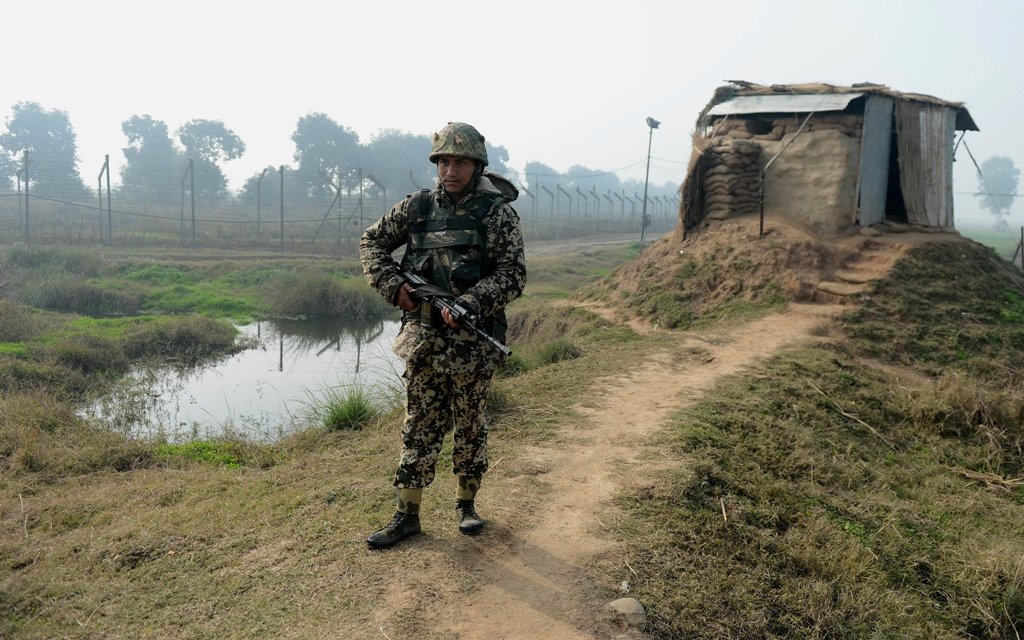
NEW DELHI: A grandmother who slipped across one of the world’s most guarded frontiers and a new border post being built in response could have been the catalysts for the worst flare-up between the armies of India and Pakistan since 2003, a newspaper report and a resident said.
At least four soldiers, two from each side, have been killed in clashes since last Sunday in disputed Kashmir, where the nuclear-armed enemies are separated by a Line of Control (LoC) set up in 1948.
Taken together, it is the worst violation of a nine-year ceasefire along the 740-km (460-mile) zig-zag line across the mountainous Himalayan region, although exchanges of gun and mortar fire are commonplace. Both armies are said to maintain snipers and special assault teams close to the line.
“It still is an eyeball-to-eyeball confrontation. On some days, people can’t step out of the post. If you come out for water, there is firing,” said Gurmeet Kanwal, a retired Indian army brigadier who has commanded troops on the line.
The two countries have fought three wars since they gained independence from colonial Britain in 1947, two of them over Kashmir, a region they both claim. On at least two other occasions, they have come close to war.
While the two countries share a formal international border to the south, all the way down to the Arabian Sea, the Kashmir ceasefire line is where the armies are on a knife-edge.
Strung out on remote outposts in snow-capped mountains and over deep valleys, in some places the soldiers are as little as 50 metres (yards) apart.
In other areas, there is a strip of land between the actual line and a barbed wire fence constructed by India.
The fighting can be controlled but merciless. Every violation of the ceasefire by one side is replied in kind by the other. If a soldier is killed on one side, almost certainly one will be killed on the other within days.
The roots of this week’s clashes could be traced to Reshma Bi, a 70-year-old woman who slipped across from Charonda village in India-held Kashmir’s Uri district to the Pakistani side in September, to join her sons and grandchildren, India’s The Hindu newspaper reported.
Indian authorities, worried about the vulnerability of the LoC, began building a new bunker near the frontier to house additional troops, Reyaz Ahmad, a resident of Charonda, told Reuters. He said it happened soon after Reshma Bi’s flight, but could not say if the two incidents were related.
Subsequently, Pakistani troops began making announcements by loudspeaker asking the Indians not to proceed with the construction. “There were announcements from the Pakistani side for several days to stop the work,” Ahmad said in a telephone conversation.
While the Pakistani position was that any construction within 500 metres (yards) of the LoC was prohibited under the terms of the ceasefire agreement, India proceeded on the grounds that the bunker was facing the village and not the LoC, and so should not be a problem.
“We can build defences on our side of the LoC. They are doing the same thing that they did when we were trying to construct the fence,” said a defence official in New Delhi who asked not to be named due to the sensitivity of the issue.
Tit-for-tat
Soon after the loudspeaker warnings, firing erupted in the area in October in which India said three villagers were killed, blaming the deaths on Pakistan.
Since then tensions have been running high and, last Sunday, a Pakistani soldier was killed in what Islamabad said was a cross-border raid mounted by the Indians. The Indian army denied any of its troops breached the control line, but said there had been an exchange of fire.
Two days later, further south along the LoC in the Mendhar district, two Indian soldiers were killed in a thick forest after what Indian officials said was a deep incursion into their territory by Pakistani forces.
Indian Brigadier Jayant K. Tiwari, the local commanding officer, said the head of one of the bodies had been “badly severed”.
On Thursday, hostilities erupted again in another part of the ceasefire line, and this time Pakistan said one of its soldiers had been killed.
“It is a live LoC. It’s not marked by boundary pillars. So this is par for the course,” said Kanwal, the retired Indian officer.
In Pakistan, a retired general who has also served on the LoC, said the fighting would not escalate.
“There will be talks on the hotline between the two sides. They will resolve this,” the retired general said. “It is not something in the scheme of HQ (headquarters), it is a lower level skirmish.”
Nevertheless, clashes have been rising along the LoC in Kashmir since the November 2008 attacks in Mumbai by militants from Pakistan, which led to a deep chill in ties between the two countries.
Last year, there were 117 violations of the ceasefire, nearly double the previous year’s 61 incidents and up from 57 in 2010, according to Indian government figures.
Most have taken place in the southern stretch of the LoC, which India says is the most-used route for infiltration of militants from Pakistan into its side of Kashmir.
“There’s been an increase in ceasefire violations. There been an increase in infiltration attempts. That is a fact. And that is something that we are dealing with, both ourselves and with the Pakistani authorities,” Shivshankar Menon, India’s national security adviser, told reporters on Thursday.
Pakistan denies it is helping push militants across and Foreign Minister Hina Rabbani Khar said this week that her country was committed to the ceasefire in Kashmir.
With tensions rising in recent days, villagers on the Pakistani side have also reported an increase in military activity.
“I’ve seen big movements of army in small and big vehicles since yesterday,” said Naveed Chaudhry in the Kotli district of Pakistan-held Kashmir. “It is unusual and we are worried what is going to happen.”
But away from the frontline, top officials in the two countries have sought to contain the fallout from the clashes on the Kashmir frontline.
“Pakistan has its hands full with a full-blown insurgency inside its borders. It doesn’t suit Pakistani interests at all to raise the temperature along the LoC,” said Pakistani senator Mushahid Hussain, who is also a member of parliament’s committer on national security.
A top Indian national security official also said that the trouble at the frontier would be contained and not drag down the fragile relationship.
“This is not the first time this has happened and not the sum total of our relations. It is Pakistan we are dealing with, give them some time,” said the official, who asked not to be named.
COMMENTS (16)
Comments are moderated and generally will be posted if they are on-topic and not abusive.
For more information, please see our Comments FAQ














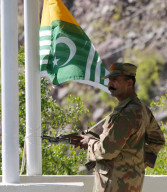
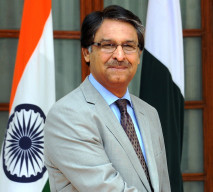
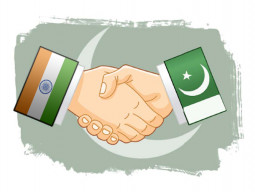

1713264570-0/Tribune-Collage-Feature-Images-(9)1713264570-0-270x192.webp)
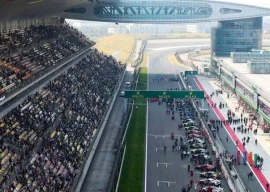
























@Mustafa Khan: Agreed, for a common Pakistani India is No. 1 enemy. Did India itself thrived for that position or Pakistan chose to give it this title ? Who made India No. 1 enemy of Pakistan ? .......it is Pakistan itself. Every enemy needs a reason for it to top the enmity list. It is silly that many Pakistanis believe that India is "khamokha" their enemy. Think right from Partition till date what we took away from India and why India treats us like enemy if not "No. 1 enemy" as we claim India to be.
@Saki Naka: wht abt Shias Ahmedis & Baloch persecuted by Pakistan? kindly manage wht u have b4 dreaming abt annexing Kashmir. this is not 712AD tht u can just waltz in and capture the region. Kindly get out of the grand dreams of Zaid Hamid. Apna mulq sambhaalo Karachi KPK aur Balochistan dekho aur Vaadi ko bhul jao U aint gonna win it by any kind of war covert or overt. Tackle the TTP first
This story is a regurgitation of The Hindu story written by Reuters, which had been refuted in certain facts.
Here is the real cause and effect: following whatever time frame the old grandma was freely crossing the border, India was building border post bunkers, which PAK did not like; PAK started to shell the bunker on the Indian side, killing villagers, just before Jan5/6 and Indians retaliated and killed a PAK soldier, on Jan5/6 and PAK crossed LOC and beheaded the Indian soldiers on Jan8. .
You can blame the grandma if you want if that makes everyone happy and cool down, but the fact remains that the PAK shell killed Indian villagers on Jan 5/6, which in turn was responded by Indians and now LOC is in hot seat?
Let us not loose the side of the facts. Indians have proof that PAK crossed LoC. Does PAK have one?
So all this mess started over a new checkpost built by the Indian Army. Means Pakistani Army was the first who started it coz they didn't agree with the new post. Am I correct?
There are still some western / Indian agents, who still believe that India is most favorite nation, and we can do trade with them, but it is very much clear that India is our enemy No.1. but most of these agents are holding our media and Govt posts, which I think needs to be purified
I thing we should understand that sooner or later , India is going to attack us, so not only our Army should be prepare for that, but also the nation, and nation should be given armed training, our fears can not go away by closing our eyes, this is the only guarantee of our survival, other wise we are going to be slaves again,
@roadkashehzada: "@tony Singh: check average heat (can be read as hate) of comments at two places"
Have Indian soldiers crossed LOC and gone over to other side? No. Has any Pakistani soldier been beheaded? any soldier mutilated? No. The severity of the actions translate into the nature of response.
Pakistani Arm has provoked this attack to damage the on going process of normalization the relations with India i.e visa regime and Trade, MN status etc. Pak Army Generals are not yet ready to accept new emerging relations.
@tony Singh: check average heat (can be read as hate) of comments at two places
@shaheer: Not a fair comparison. Times of India is essentially a Tabloid. We have our share of so called News papers that act like tabloids as well.
@shaheer: Read comments on PKKH too! It take all kinds to make the world.
It's just funny how we "Pakistanis" have such moderate and conservative reviews and comments regarding this thread. Now, read the comments on www.timesofindia.com on the LOC article, you will see how immature and Idiots Indians are..
"Subsequently, Pakistani troops began making announcements by loudspeaker asking the Indians not to proceed with the construction. “There were announcements from the Pakistani side for several days to stop the work,” Ahmad said in a telephone conversation."
Complete lie since the grand mother crossing incident happened in sept 11 not now.
Provocation and LOC ceasefire violation started by pakistan and not India 1st of all Indian army is right when they said that there is no link between Kashmiri grandmother crossing loc in sept 2011 and incident happening nearly 16 months latter i.e. current incident. If pakistan army thinks that Indian army violated cease fire by building bunkers then why don’t they fire at Indian post at that point of time and why now?? 2nd thing is if pakistan army thinks that Indian army violated cease fire by building bunkers then why don’t they officially lodge protest with their govt or call on for commander level meeting with their Indian counterpart. 3rd thing is pakistan army instead of raising the issue 16 month before they are firing now on Indian army check posts to warn them and that too with heavy mortars that lead to a destruction of a civilian house. So it doesn’t make any sense and is a clear sign of Pakistan’s provocation and Pakistan violated ceasefire first by firing across LOC not India, Indian army only retaliated. If Pakistan army had any problem on LOC then they should have lodged formal protest with Indian army instead of warning them with heavy mortars but pakistan army they chooses firing not dialogue. Calling it less than one sided is just unjustified and that’s what Indian army said parts of Hindu report is incorrect. After all those bunkers are old bunkers not new ones which they while repairing pakistan started firing thinking otherwise. pakistan violated LOC ceasefire and provoked India first.
@Saki Naka:
LOL
Thanks for informing us of Indian Opinion about the skirmish, lets hear now from Pak Army officials too please!
The grandmother was Sakeena Biwi's mother. This is story of one such Sakeena Biwi, there are millions of such Sakeena Biwis being persecured by India.